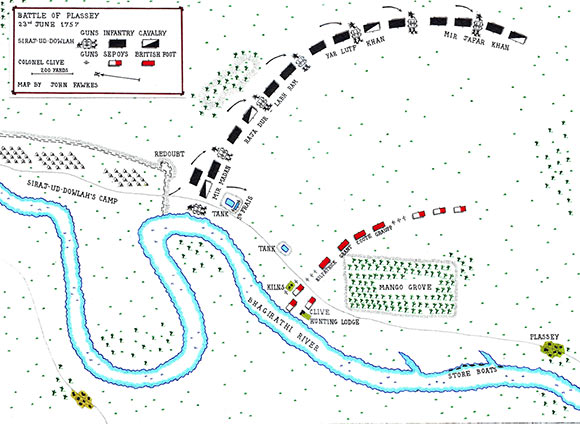
European states had established trade ports in India since the arrival of the Portugese in the early 16th century CE.
The Portugese, Dutch, French and British all had several footholds on the coast of the sub-continent.
They traded from there and sometimes also lend a military hand in conflicts among Indian rulers.
Things escalated from the War of the Austrian Succession and even more during the Seven Years' War,
when Britain and France wrestled to toss each other out of India.
When Siraj-ud-daulah gained the throne of Bengal in 1756 CE, he reversed his father's policy of appeasing the British and quickly went to war with them.
He took the fort and factory of Cossimbazar and then overran Calcutta in four days.
Several European prisoners died overnight in a dungeon and their number was blown up by a witness, causing outrage in Britain.
The British East India Company ordered their deputy governor Robert Clive to make a countermove, which he did by retaking the city.
Nawab Siraj returned to take Calcutta once more, but was repulsed.
Because Siraj had trouble on his western borders with Afghans and Mahrattas, he signed a treaty with the British.
The dust could have settled there and then, but Clive, who had heard about the outbreak of the Seven Years' War, now turned his attention to the French.
He captured and plundered Chandernagar and then, defying his orders, did not return to Madras but remained in Bengal.
Siraj's commander had been bribed and had kept aside, however his nawab was infuriated with the fate of the city.
He allied himself with the French.
Time was on his side, but he foolishly moved to attack Clive again.
Several of his senior officers, at odds by his policies, were promised high positions in the government by Clive.
The most prominent among them was Mir Jafar, the Bengal army paymaster, who was offered to become the new nawab.
After all the intrigue, the British force marched towards the Bengals.
Clive commanded a little over 3,000 men, 2/3 Indian sepoys and the rest a mix of Europeans and sailors.
He brought ten field guns; eight were 6-pounders and two howitzers.
The Bengals fielded a vastly superior army: 40,000 infantry and 20,000 cavalry.
Most of the infantry was of dubious quality, though many among the cavalry were experienced Pathans.
They also had 53 guns, mostly cumbersome 18-, 24- and 32-pounders, laboriously dragged onto the battlefield by oxen and elephants.
Supplementing them were another 50 French artillerymen with six guns.
The British force crossed the Bhagirathi River around noon and fortified itself in Laksha Bag, a small mangrove grove near the village of Plassey.
The Bengals had reached the place a day earlier, but did not attack until the following day.
The battle started in the morning with an artillery duel, pinning the infantry and cavalry down.
The British suffered a few casualties.
As they could not afford even those, they retreated behind a mound surrounding Laksha Bag, where they enjoyed cover.
The artillery fire continued for three hours and then was interrupted by early heavy monsoon rain.
The British covered up their ammunition, but the Bengal gunpowder got soaked.
On both sides the rate of fire dropped and the Bengal general Mir Madan Khan pounced on the opportunity by launching a cavalry charge.
This was met with a short but devastating salvo of grape shot that broke the attack and mortally wounded the general.
Siraj's remaining generals, commanding the greater part of the army, were all disloyal.
Throughout the battle Mir Jafar and the other conspirators did not make a move and both Siraj and Clive remained unsure of their loyalty.
In the afternoon, the nawab ordered his troops to retreat behind entrenchments and abandoned the battle.
Because the retreat was not entirely synchronous, the British now saw openings and advanced.
Siraj's loyal soldiers took up the fight, however their rate of fire of about 1 shot per 15 minutes fell far short of the British 2 - 3 per minute.
The French gunners were more effective, but too few in number to stop the British in what was still essentially an artillery battle.
Clive's force moved forward in phases and captured Siraj's camp in the late afternoon.
By then the battle was over.
Fleeing Bengals were pursued until nightfall.
The British lost approximately 22 killed and 50 wounded; the Bengals lost 500 men, some horses and elephants and all their guns.
Though militarily a sideshow, the battle confirmed that Siraj's political support had evaporated.
He tried to escape, but was murdered shortly after.
Before that, Clide had already installed Mir Jafar as nawab.
The two made a treaty that gained Britain a lot of territory in Bengal, brought misery to Bengal itself and ended the French presence there.
The remaining French and Dutch forces were ousted in four years.
The battle gave Britain a free hand in India and transformed the East India Company from a trading company to a land power,
which expanded its influence by playing divide and conquer among the Indian rulers.
The British did not gain all of India right away; that took several wars, many battles and a century more.
War Matrix - Battle of Plassey
First Industrial Revolution 1750 CE - 1830 CE, Battles and sieges


